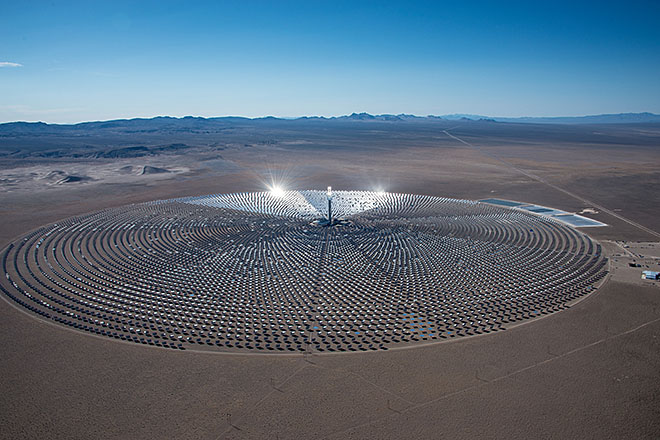S&P Global Offerings
Featured Topics
Featured Products
Events
S&P Global Offerings
Featured Topics
Featured Products
Events
S&P Global Offerings
Featured Topics
Featured Products
Events
Banking & Capital Markets
Economy & Finance
Energy Transition & Sustainability
Technology & Innovation
Podcasts & Newsletters
Banking & Capital Markets
Economy & Finance
Energy Transition & Sustainability
Technology & Innovation
Podcasts & Newsletters
S&P Global Offerings
Featured Topics
Featured Products
Events
25 Aug, 2021

|
Southwest Gas Holdings Inc. aims to harness solar energy to power the technology behind green hydrogen and displace natural gas in its distribution systems. |
Southwest Gas Holdings Inc. is preparing to pilot hydrogen blending in natural gas infrastructure as the company positions itself for a role in the emerging U.S. hydrogen economy.
The company — which distributes gas in Arizona, California and Nevada — is partnering with Arizona State University and the University of Nevada Las Vegas to launch two hydrogen blending pilot projects. The company shared details of the projects, previously mentioned on quarterly conference calls, and elaborated on its hydrogen ambitions in a recent interview with S&P Global Market Intelligence.
"We want to be involved in those types of pilot projects because we think that's where things are going down the road," Southwest Gas President and CEO John Hester said. "We think that the availability of [renewable natural gas] and hydrogen, and the economics associated with it, are just going to continue to improve year on year for the foreseeable future."
Pilots set to begin
Southwest Gas will use the two pilot projects to determine the optimal blend of hydrogen and natural gas for safety and the environment, including the physical impacts of hydrogen on distribution system infrastructure and common gas appliances. The company will also study the economics of hydrogen and its effects on heating times when blended with natural gas. Southwest Gas intends to study hydrogen blends of up to 20% in closed gas systems at training facilities in Tempe, Ariz., and Henderson, Nev.
The projects are slated to begin in the fourth quarter. The first phase will last several months and help determine the scope and duration of future phases, according to the company.
While the company will initially use pre-purchased, bottled hydrogen for the pilots, the goal is to tap solar power to operate an electrolyzer and produce hydrogen for injection into Southwest Gas Corp.'s distribution system, Hester said. Electrolyzers separate water into hydrogen and oxygen. When the process is powered by renewable electricity, the product is called green hydrogen.

Green hydrogen trades at a steep premium to natural gas, but Hester noted that the Biden administration plans to make the zero-carbon fuel more competitive. Since then, the U.S. Energy Department announced a program that aims to slash green hydrogen costs by 80% within 10 years, and the U.S. Senate passed an infrastructure bill that would fund a revamped DOE hydrogen program.
In Hester's view, the U.S. has the potential to bend the green hydrogen cost curve, the same way the nation tamed solar photovoltaic prices over the last two decades.
"It was the most expensive source of electricity at the time. Now it's the cheapest," Hester said. "So a lot can happen over a relatively short period of time when you have motivated suppliers and motivated consumers and technological developments to facilitate those interests."
Pathways to hydrogen distribution
Hester highlighted discussions with a large resort in Las Vegas that inquired about running its operations entirely on hydrogen. The CEO said in the interview that the project is "definitely viable," and Southwest Gas is pursuing other hydrogen pathways as well.
In one pathway, Southwest Gas would blend hydrogen into its gas distribution systems, an application that several U.S. gas utilities are piloting or planning to demonstrate. But Hester also sees potential for portions of the gas distribution system to carry pure hydrogen.
Research has indicated that hydrogen presents the greatest pipeline integrity risk when present at high pressure and in high concentrations in certain steel pipes. Low-pressure distribution systems present less risk, and distributors with high percentages of plastic pipe are considered to be better positioned for uptake. Roughly 86% of Southwest Gas' system mileage consisted of plastic pipe in 2019, according to a Market Intelligence analysis of U.S. Pipeline and Hazardous Materials Safety Administration data.
Asked whether operating pure hydrogen distribution segments is a 2030 goal, Hester said it could be technically achievable over a shorter period of time, perhaps within three years. "As long as you have the system set up properly, and then the appliances are calibrated to receive the hydrogen, it's just not really that difficult from an engineering perspective."
